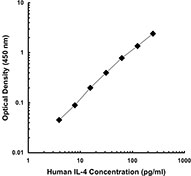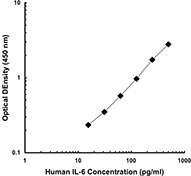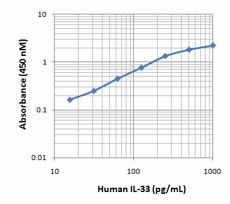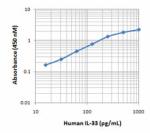- Clone
- Poly5163 (See other available formats)
- Regulatory Status
- RUO
- Other Names
- Interleukin-33
- Isotype
- Goat Polyclonal Ig
- Ave. Rating
- Submit a Review
| Cat # | Size | Price | Quantity Check Availability | Save | ||
|---|---|---|---|---|---|---|
| 516303 | 50 µg | £257 | ||||
IL-33, also known as NFHEV and DVS 27, is a 30 kD proinflammatory protein that belongs to IL-1 superfamily. IL-33 is constitutively expressed in smooth muscle and airway epithelia. It is upregulated in arterial smooth muscle, dermal fibroblasts, and keratinocytes following IL-1α or IL-1β stimulation. IL-33 interacts with IL1RL1/ST2 receptor and IL-1 receptor accessory protein (IL1RAP) in order to activate intracellular molecules in the NF-κB and MAP kinase signaling pathways that drive production of type 2 cytokines (e.g. IL-5 and IL-13) from polarized Th2 cells. Recombinant IL-33 has been shown to enhance Th2-associated immune responses and potently increase mast cell proliferation and cytokine production.
Product DetailsProduct Details
- Verified Reactivity
- Human
- Antibody Type
- Polyclonal
- Host Species
- Goat
- Immunogen
- Human IL-33, amino acids Ser112-Thr270 (Accession# NM_ 033439) was expressed in E. coli.
- Formulation
- Phosphate-buffered solution, pH 7.2, containing 1% BSA (USA origin) and 0.09% sodium azide.
- Preparation
- The antibody was purified by antigen affinity chromatography, and conjugated with biotin under optimal conditions.
- Concentration
- 0.2 mg/ml
- Storage & Handling
- The antibody solution should be stored undiluted between 2°C and 8°C. Do not freeze.
- Application
-
ELISA Detection - Quality tested
- Recommended Usage
-
Each lot of this antibody is quality control tested by ELISA assay. For use as an ELISA detection antibody, a concentration range of 0.125-0.5 µg/ml is recommended. It is recommended that the reagent be titrated for optimal performance. To obtain a linear standard curve, serial dilutions of IL-33 recombinant protein ranging from 1000 to 15.6 pg/ml are recommended.
- Application Notes
-
ELISA Detection: The biotinylated Poly5163 antibody is useful as a detection antibody in a sandwich ELISA assay, when used in conjunction with purified Poly5163 (Cat. No. 516301) antibody as the capture antibody and recombinant human IL-33 (Cat. No. 581809) as the standard.
- RRID
-
AB_2561413 (BioLegend Cat. No. 516303)
Antigen Details
- Structure
- 270 aa with predicted molecular weight of 30 kD.
- Distribution
- Full length IL-33 localizes to the nucleus in HUVECs and transfectants C-terminal fragment, corresponding mature IL-33 is secreted.
- Function
- Cytokine that binds to and signals through IL1RL1/ST2 and its stimulation recruits MYD88, IRAK1, IRAK4, and TRAF6, followed by phosphorylation of MAPK3/ERK1 and/or MAPK1/ERK2, MAPK14, and MAPK8. Induces T helper type 2-associated cytokines.
- Interaction
- Binding to IL1RL1/ST2 and IL-1 receptor accessory protein.
- Cross
- In sandwich ELISA, no cross-reactivity with mouse or rat IL-33.
- Biology Area
- Immunology
- Molecular Family
- Cytokines/Chemokines
- Antigen References
-
1. Lohning M, et al. 1998. P. Natl. Acad. Sci. USA 95:693.
2. Onda H, et al. 1999. J. Cerebr. Blood F. Met. 19:1279.
3. Schmitz J, et al. 2005. Immunity 23:479.
4. McLaren JE, et al. 2010. J. Immunol. 185:1222. - Gene ID
- 90865 View all products for this Gene ID
- UniProt
- View information about IL-33 on UniProt.org
Related FAQs
- How many biotin molecules are per antibody structure?
- We don't routinely measure the number of biotins with our antibody products but the number of biotin molecules range from 3-6 molecules per antibody.
Other Formats
View All IL-33 Reagents Request Custom Conjugation| Description | Clone | Applications |
|---|---|---|
| Purified anti-human IL-33 | Poly5163 | ELISA Capture |
| Biotin anti-human IL-33 | Poly5163 | ELISA Detection |
Customers Also Purchased

_100913.jpg)


Compare Data Across All Formats
This data display is provided for general comparisons between formats.
Your actual data may vary due to variations in samples, target cells, instruments and their settings, staining conditions, and other factors.
If you need assistance with selecting the best format contact our expert technical support team.

 Login / Register
Login / Register 

















Follow Us